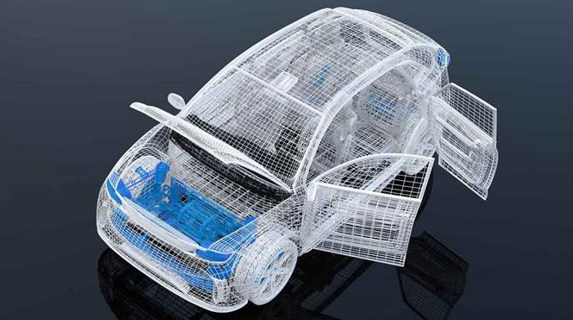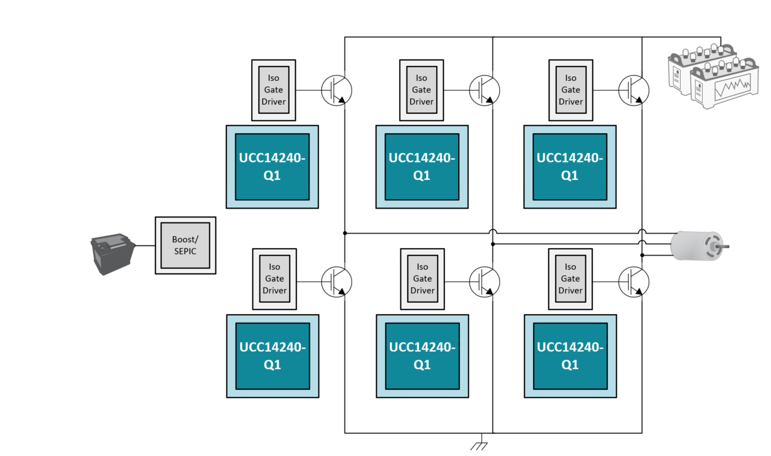Electric vehicle (EV) and hybrid electric vehicle (HEV) are evolving, and the electronic equipment is also changing. More and more electronic devices play an important role in the overall structure and function of these vehicles. However, the driver has not changed. They still hope that their electric vehicles and hybrid electric vehicles can travel farther smoothly, become more economical, charge faster, and ensure their safety. So how can designers provide them with more services at a lower cost?

With the increasingly stringent requirements for safety, power density and electromagnetic interference (EMI), different power architectures have emerged to meet these challenges, including the distributed power architecture with independent bias power supply for each critical load.
Traditional power architecture in electric vehicles
Automotive design engineers can design solutions for some power architecture according to the power requirements of electric vehicles. The traditional method shown in Figure 1 is a centralized power architecture, which uses a central transformer and a bias controller to generate bias voltages for all gate drivers.

Figure 1: centralized architecture in hybrid electric vehicle / electric vehicle traction inverter
This solution has always been popular because of the low cost of a centralized architecture, but it may be difficult to manage faults and regulate voltage, and the layout is challenging. The centralized architecture is also vulnerable to more noise, and the components in a system area are high and heavy.
Finally, as reliability and safety become the top priority, the power supply of the centralized architecture lacks redundancy. If a single component in the bias power supply fails, it may lead to large-scale system failure. Deploying a distributed architecture can prevent power failures, resulting in more reliable systems.
High reliability through distributed architecture
If a small electronic component in the traction inverter motor fails when the vehicle is driving at the speed of 65 mph, we certainly don't want the vehicle to suddenly fail or stop completely. Safety redundancy and standby power supply in powertrain system have become standard configuration to ensure safety and reliability.
The distributed power architecture can allocate a dedicated, local and easily adjustable bias power supply close to each grid driver to meet the reliability requirements in the application environment of electric vehicles. Therefore, it can provide redundancy and improve the response ability of the system to single point of failure. For example, if one of the bias power supplies matched with the grid driver fails, the other five bias power supplies and their matched grid drivers can still operate normally. If five of the six grid drivers can still operate normally, the motor can slow down and shut down in a good control manner, or may continue to operate. With this power system design, the passengers in the vehicle will not even be aware of the problem.
External transformer bias power supplies (such as flyback and push-pull controllers) are high, heavy and occupy a large area, which hinders the use of distributed architecture in light electronic equipment. Electric vehicle power supply system needs more advanced devices, that is, smaller integrated transformer modules, such as ucc14240-q1 isolated DC / DC bias power module, which can integrate transformers and components into an optimized planar magnetic component module solution with low height.
The size, height and weight of the power supply system can be greatly reduced by integrating the planar transformer into the package of the size of the integrated circuit. Ucc14240-q1 integrates transformer and isolation, provides simple control and low primary to secondary capacitance, and improves common mode transient immunity (CMTI) in dense and fast switching applications. The primary and secondary side control and isolation are fully integrated to achieve a stable ± 1.3% isolated DC / DC bias power supply in one device. By achieving an output power of 1.5W, even at temperatures up to 105 ° C, ucc14240-q1 can power the gate driver in the distributed architecture, as shown in Figure 2.

Figure 2: distributed architecture in traction inverter of electric / hybrid vehicle using ucc14240-q1
Other considerations for driving powertrain systems in a distributed architecture
Electric vehicles need high standards of reliability and safety, which will penetrate into various power conversion electronic devices. The element must operate in a controlled and validated manner at an ambient temperature of 125 ° C and above. Isolated grid drivers need to be "smart" and include a number of safety and diagnostic functions. The low-power bias power supply for grid drivers and other electronic devices in the system also needs to be improved, including low EMI. Ucc14240-q1 uses ti's integrated transformer technology and uses 3.5pf primary to secondary capacitor transformers to reduce EMI generated by high-speed switches and easily realize CMTI of more than 150V / NS.
The bias power supply is close to the isolated grid driver in the distributed architecture, which can ensure simpler printed circuit board layout and wiring and better adjust the voltage supplied to the grid driver, and finally drive the grid of the power switch. These factors can improve the efficiency and reliability of traction inverter, which can usually operate at 100kW to 500kW. These high-power systems need higher efficiency to ensure less heat loss, because thermal stress is one of the main causes of component failure.
With the increasing power requirements of these electric vehicle power systems, it is time to consider using silicon carbide and gallium nitride power switches to achieve smaller and more efficient power supply. Both semiconductor technologies have some advantages, but the gate driver voltage needs to be adjusted more strictly than the mature traditional insulated gate bipolar transistor. They also need to provide components with low capacitance and high CMTI on the safety barrier because they switch high voltage faster than previously thought.
Electric vehicles will move towards higher reliability and longer driving distance in the future
Drivers will continue to expect to buy vehicles with lower emissions, longer range, higher safety and reliability and more functions at a lower price. Only with the continuous progress of power electronics technology can these needs for electric vehicles be met, including the innovation of power architecture and its related isolated grid driver and bias power supply.
Switching to distributed power architecture greatly improves reliability in isolated high voltage environment, but the challenge is that additional components will lead to higher requirements for weight and size. Fully integrated power solutions (such as ucc14240-q1 bias power module switching at high frequency) can save system level space and achieve lightweight.